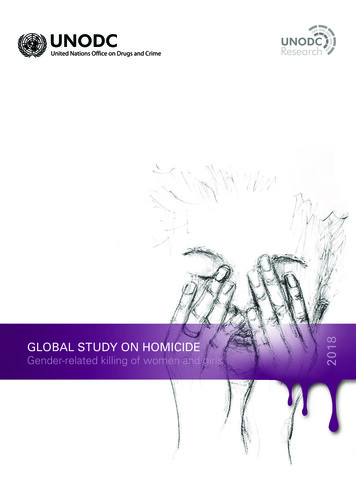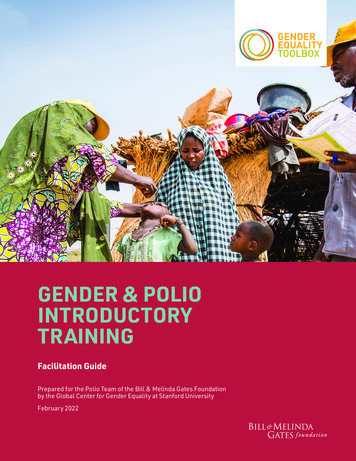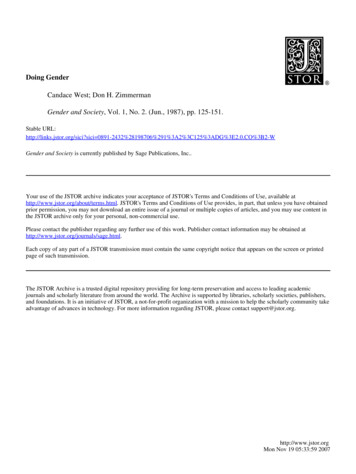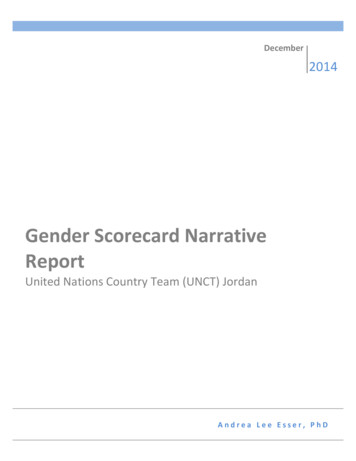
Transcription
Gender-related killing of women and girls2018GLOBAL STUDY ON HOMICIDE
UNITED NATIONS OFFICE ON DRUGS AND CRIMEViennaGLOBAL STUDY ON HOMICIDEGender-related killing of women and girls2018
The gender‐related killing of women and girlsDISCLAIMERS United Nations, November 2018. All rights reserved worldwide.This publication may be reproduced in whole or in part and in any formfor educational or non-profit purposes without special permission fromthe copyright holder, provided acknowledgement of the source is made.The United Nations Office on Drugs and Crime (UNODC) would appreciatereceiving a copy of any publication that uses this publication as a source.Suggested citation: UNODC, Global Study on Homicide 2018 (Vienna, 2018)No use of this publication may be made for resale or any other commercialpurpose whatsoever without prior permission in writing from UNODC.Applications for such permission, with a statement of purpose and intent of thereproduction, should be addressed to the Research and Trend Analysis Branch of UNODC.DISCLAIMERThe content of this publication does not necessarily reflect the views orpolicies of UNODC or contributory organizations, nor does it imply any endorsement.Comments on the report are welcome and can be sent to:Division for Policy Analysis and Public AffairsUnited Nations Office on Drugs and CrimePO Box 5001400 ViennaAustriaTel: ( 43) 1 26060 0Fax: ( 43) 1 26060 58272
Gender‐related killing of women and girlsPrefaceHomicide represents the most extreme form of violence against women, a lethal act on a continuum ofgender-based discrimination and abuse.As this research shows, gender-related killings of women and girls remain a grave problem across regions,in countries rich and poor. While the vast majority of homicide victims are men, killed by strangers, womenare far more likely to die at the hands of someone they know.Women killed by intimate partners or family members account for 58 per cent of all female homicidevictims reported globally last year, and little progress has been made in preventing such murders. Targetedresponses are clearly needed.This booklet – part of the forthcoming Global Study on Homicide by the United Nations Office on Drugs andCrime (UNODC) – is being released on the International Day for the Elimination of Violence against Women2018 to raise awareness, increase understanding and inform action.It is also a call for Governments to help us shed further light on these challenges by collecting the neededdata and reporting on all forms of gender-based violence.UNODC remains committed to supporting Member States to strengthen evidence-based policies andcriminal justice responses that can prevent and end violence against women and gender-related killings.Yury FedotovExecutive Director, United Nations Office on Drugs and Crime3
AcknowledgementsGender-related killing of women and girls was prepared by the Research and Trend Analysis Branch,Division for Policy Analysis and Public Affairs, United Nations Office on Drugs and Crime, under thesupervision of Jean-Luc Lemahieu, Director of the Division, and Angela Me, Chief of the Research and TrendAnalysis Branch.General coordination and content overviewAngela MeAndrada-Maria FilipMarieke LiemAnalysis and draftingAndrada-Maria FilipJonathan GibbonsMarieke LiemKristiina KangaspuntaData management and estimates productionEnrico BisognoDiana CameriniSarika DewanMichael JandlAlexander KampradMateus Rennó SantosGraphic design and productionAnja KorenblikSuzanne KunnenKristina KuttnigAdministrative supportIulia LazarReview and commentsGender-related killing of women and girls benefited from the expertise of and invaluable contributionsfrom UNODC colleagues in all divisions and field offices. Particular thanks are owed to the Justice Sectionof the Division of Operations and the Gender Team at the Office of the Executive Director.Cover drawing Yasser Rezahi; photo of artwork Fabian Rettenbacher.The research for this study was made possible by the generous contribution of Sweden.4
Gender‐related killing of women and girlsContentsPreface . 3Contents . 5Scope of the study . 7Introduction to the concept of gender-related killing of women and girls . 8Key findings . 10Intimate partner/family-related killing of women and girls: scale of the problem . 13Scale of the problem in numbers of victims .13Scale of the problem in homicide rates .13Scale of the problem in shares of all women murdered.17Female burden of intimate partner/family-related homicide .18Male and female rates of intimate partner/family-related homicide .19Male and female rates of intimate partner homicide .21The context of gender-related killing of women and girls .22Defining and understanding gender-related killing of women and girls. 24Clustering gender-related killings of women and girls into different forms .29Perpetrators of intimate partner killings of women and girls . 38Victim and perpetrator characteristics .38Motives of perpetrators of intimate partner killings of women and girls .39Link between lethal and non-lethal violence against women . 41Criminal justice and policy responses to gender-related killing of women and girls. 47International responses .47National responses .48Conclusions and Policy Implications . 55Annex . 575
Gender‐related killing of women and girlsScope of the studyThis study gives an overview of the scope of gender-related killing of women and girls. It provides in-depthanalysis of killings perpetrated within the family sphere and examines forms of gender-related killingsperpetrated outside the family sphere, such as the killing of women in conflict and the killing of female sexworkers. The study explores the scale of intimate partner/family-related killings of women and girls, anddescribes different forms of gender-related killings of women. It also looks at the characteristics of theperpetrators of intimate partner killings, the link between lethal and non-lethal violence against women,and the criminal justice response.The availability of data on intimate partner/family-related homicide means that such killings of females areanalysed in greater depth than other forms of “femicide”1 and that the analysis focuses on how womenand girls are affected by certain norms, harmful traditional practices and stereotypical gender roles.Although other forms of gender-related killing of women and girls are described, such as female infanticideand the killing of indigenous or aboriginal women, given severe limitations in terms of data availability,only literature-based evidence is provided.The data presented in this study are based on homicide statistics produced by national statistical systemsin which the relationship between the victim and perpetrator or the motive is reported. While thedisaggregation of homicide data at country level has improved over the years, regional and global estimatesare based on a limited number of countries, with Africa and Asia accounting for most of the gaps. .1Throughout this study the word “femicide” is written with quotation marks when it refers to a concept that is not clearly defined andcovers acts subject to a certain degree of interpretation. Femicide is written without quotation marks when referring to countries in LatinAmerica that have defined this concept in their national legislation.7
Gender‐related killing of women and girlsIntroduction to the concept of gender-related killingof women and girlsThe focus of this study is on the killing of women and girls as a result of gender norms. Among the manydocuments that draw attention to the alarming proportions reached by this phenomenon in all its differentmanifestations, the 2013 United Nations General Assembly resolution on “Taking action against genderrelated killing of women and girls” is noteworthy. 2Some national Governments, international organizations, academics and advocates of women’s rights usethe term “femicide” to refer to this problem. The notion of gender-related killing, or “femicide”, requiresan understanding of which acts are gender related; something that is subject to a certain degree ofinterpretation. For example, in many cases there is a continuum of (intimate partner) violence thatculminates in the killing of women even when perpetrators have no specific (misogynistic) motives.Nevertheless, some aspects of gender-related killing of women are indisputable, one being that this typeof homicide is part of female homicide, yet not all female homicides are gender related. Therefore, only aspecific, if considerable, share can be labelled “gender-related killings of women and girls”, i.e. “femicide”.Gender-related killings of women and girls are committed in a variety of contexts and through differentmechanisms. In broader terms, such killings can be divided into those perpetrated within the family andthose perpetrated outside the family sphere. Data availability at regional and global level show that thevast majority of cases of this type of crime fall into the first category.Gender-related killing of women and girls is analysed in this study using the indicator for intimatepartner/family-related homicide. This provides a concept that covers most gender-related killings ofwomen, is comparable and can be aggregated at global level. Other existing national data labelled as“femicide” are not comparable as countries use different legal definitions of this concept when collecting .2United Nations General Assembly Resolution 68/191 specifically states: “Deeply concerned that the global prevalence of differentmanifestations of the gender-related killing of women and girls is reaching alarming proportions, Concerned about violent genderrelated killing of women and girls, while recognizing efforts made to address that form of violence in different regions, including incountries where the concept of femicide or feminicide has been incorporated into national legislation, draws attention to the alarmingproportions reached by this phenomenon in all its different manifestations. The resolution also noted that gender-related killing ofwomen and girls has been criminalized in some countries as “femicide” or “feminicide” and has been incorporated as such intonational legislation in those countries.8
Gender‐related killing of women and girlsdata. Where data are available, however, it is clear that intimate partner/family-related homicide coversmost of the killings categorized as “femicide” and is a good fit for analysing trends in the latter.UNODC collects data from Member States on intimate partner/family-related homicide as a proxy forgender-related killings of women and the broad concept evolving around the notion of “femicide”. Thisindicator covers female victims of homicide perpetrated by current or former intimate partners, or otherfamily members. 3 General sex-disaggregated homicide data are collected through regular UNODC datacollection on crime. Using the framework of the International Classification of Crime for Statistical Purposes(ICCS), homicide data can be categorized and analysed to define gender-related killings and quantifyintimate partner/family-related homicide.4While the majority of intentional homicide victims are male, the majority of the victims of intimatepartner/family-related homicide are women. Therefore, understanding the extent and patterns of thekilling of women and girls requires the dedicated analysis of intimate partner/family-related homicideexplored in this study. .3UNODC collects data on intimate partner/family-related homicide through the Survey of Crime Trends and Operations of the CriminalJustice System.4The ICCS disaggregates intentional homicide according to the relationship between victims and perpetrators. Victims of intimatepartner homicide include those killed by a current or former intimate partner or spouse. Victims of intimate partner/family-relatedhomicide also include those killed by a blood relative, household member or relative by marriage or adoption. More informationavailable at http://www.unodc.org/documents/ data-and-analysis/statistics/crime/ICCS/Gender and the ICCS.pdf.9
Gender‐related killing of women and girlsKey findingsA total of 87,000 women were intentionally killed in 2017. More than half of them (58 per cent) ̶ 50,000 ̶were killed by intimate partners or family members, meaning that 137 women across the world are killedby a member of their own family every day. More than a third (30,000) of the women intentionally killedin 2017 were killed by their current or former intimate partner ̶ someone they would normally expect totrust.Based on revised data, the estimated number of women killed by intimate partners or family members in2012 was 48,000 (47 per cent of all female homicide victims). The annual number of female deathsworldwide resulting from intimate partner/family-related homicide therefore seems be on the increase.The largest number (20,000) of all women killed worldwide by intimate partners or family members in 2017was in Asia, followed by Africa (19,000), the Americas (8,000) Europe (3,000) and Oceania (300). However,with an intimate partner/family-related homicide rate of 3.1 per 100,000 female population, Africa is theregion where women run the greatest risk of being killed by their intimate partner or family members,while Europe (0.7 per 100,000 population) is the region where the risk is lowest. The intimatepartner/family-related homicide rate was also high in the Americas in 2017, at 1.6 per 100,000 femalepopulation, as well as Oceania, at 1.3, and Asia, at 0.9.Even though the largest number of women and girls are killed by intimate partners or family membersin Asia, they run the greatest risk of being killed by an intimate partner or family member in Africa.The regions with the largest number of females killed purely by intimate partners (not including otherfamily members) in 2107 were Asia and Africa (11,000 each), followed by the Americas (6,000), Europe(2,000) and Oceania (200).10
Gender‐related killing of women and girlsAfrica was also the region with the highest rate of females killed purely by intimate partners in 2017 (1.7per 100,000 female population). The Americas had the second-highest rate (1.2), Oceania the third (0.9),Europe the fourth (0.6) and Asia the fifth-highest rate (0.5 per 100,000 female population).The global rate of female total homicide in 2017 was estimated to be 2.3 per 100,000 female population,the global female intimate partner/family-related homicide rate was 1.3, while the female intimate partnerhomicide rate was estimated at 0.8 per 100,000 female population.More than two thirds of all women (69 per cent) killed in Africa in 2017 were killed by intimate partners orfamily members, while more than a third (38 per cent) of women were killed by intimate partners or familymembers in Europe. Oceania accounts for the largest share of all the regions in terms of women killedexclusively by intimate partners, at 42 per cent, while Europe accounts for the lowest, at 29 per cent.Only one out of every five homicides at global level is perpetrated by an intimate partner or family member,yet women and girls make up the vast majority of those deaths. Victim/perpetrator disaggregations reveala large disparity in the shares attributable to male and female victims of homicides committed by intimatepartners or family members: 36 per cent male versus 64 per cent female victims.Women also bear the greatest burden in terms of intimate partner violence. The disparity between theshares of male and female victims of homicide perpetrated exclusively by an intimate partner issubstantially larger than of victims of homicide perpetrated by intimate partners or family members:roughly 82 per cent female victims versus 18 per cent male victims.Although women and girls account for a far smaller share of total homicides than men, they bear by far thegreatest burden of intimate partner/family‐related homicide, and intimate partner homicide.These findings show that even though men are the principal victims of homicide globally, women continueto bear the heaviest burden of lethal victimization as a result of gender stereotypes and inequality. Manyof the victims of “femicide” are killed by their current and former partners, but they are also killed byfathers, brothers, mothers, sisters and other family members because of their role and status as women.The death of those killed by intimate partners does not usually result from random or spontaneous acts,but rather from the culmination of prior gender-related violence. Jealousy and fear of abandonment areamong the motives.11
Gender‐related killing of women and girlsThrough the indicator “female victims of homicide perpetrated by intimate partners or family members”,this study quantifies a significant share of all gender-related killings of women and girls perpetratedglobally, including forms that are prevalent across certain regions, such as dowry and honour killing. Giventhe lack of data, it is not possible to quantify the number of gender-related killings outside the family, butthe study describes their different manifestations and provides examples where information is available.The information available shows that, other than gender-related killings in conflict settings, gender-relatedkillings of women and girls outside the family are relatively rare in comparison to killings perpetrated byintimate partners or other family members.Countries have taken action to address violence against women and gender-related killings in differentways, by adopting legal changes, early interventions and multi-agency efforts, as well as creating specialunits and implementing training in the criminal justice system. Countries in Latin America have adoptedlegislation that criminalizes femicide as a specific offence in their penal codes. Yet there are no signs of adecrease in the number of gender-related killings of women and girls.This study highlights what more can be done to prevent those killings. A more comprehensive range ofcoordinated services needs to be provided by police, criminal justice systems, health and social services.Moreover, in order to prevent and tackle gender-related killing of women and girls, men need to beinvolved in efforts to combat intimate partner violence/family-related homicide and in changing culturalnorms that move away from violent masculinity and gender stereotypes.12
Gender‐related killing of women and girlsIntimate partner/family-related killing of women andgirls: scale of the problemScale of the problem in numbers of victimsThe lethal victimization of women within the family sphere is encountered in all regions and countries.UNODC estimates that the deaths of women and girls resulting from intentional homicide perpetrated byan intimate partner or family member5 amounted to a global total of 50,000 in 2017.6 An improvement inthe coverage of gender-disaggregated country data has led UNODC to reevaluate the 2012 figure publishedin the previous edition of the Global Study on Homicide to 48,000. The number of female deaths resultingfrom intimate partner or family/related homicide may therefore have increased slightly.7Given that the total number of deaths of women and girls worldwide resulting from all forms of intentionalhomicide amounted to 87,000 in 2017, more than half (58 per cent) of all female victims of intentionalhomicide, or 137 every day, were actually killed by a member of their own family. The number of womenkilled purely by their intimate partners (not including those killed by family members) was 30,000, meaningthat more than one third (34 per cent) of all women and girls intentionally killed worldwide, or 82 everyday, are killed by someone whom they would normally trust and expect to care for them.Scale of the problem in homicide ratesThe number of victims is only one way of looking at the toll that intimate partner/family-related homicidetakes on women. Looking at the homicide rate per 100,000 female population offers a differentperspective. For example, in absolute numbers, the largest number of women killed by an intimate partneror family member in 2017 was in Asia (20,000), by far the most populous of the five regions. However, at3.1 per 100,000 female population, the highest rate of intimate partner/family-related homicide was inAfrica. Thus, while fewer women are killed by their intimate partner or family members in Africa than inAsia, women are actually at a higher risk of being killed by their intimate partner or family members inAfrica. Women are also most at risk of being killed by their intimate partners (not including other familymembers) in Africa (1.7 per 100,000 female population) and the Americas (1.2), while they are least at riskin Oceania (0.9), Europe (0.6) and Asia (0.5).Estimated at 1.3 per 100,000 population in 2017, although slightly lower than in 2012, when it stood at 1.4per 100,000 population, the female intimate partner/family-related homicide can be considered stable atglobal level. However, the female intimate-partner/family-related homicide rate not only has variations inthe prevalence of homicide across regions but also between countries within those regions (see box 1).These variations show that, in general, countries with relatively low female total homicide rates tend tohave a relatively larger share of female intimate partner/family-related homicides, whereas in countrieswith relatively high female total homicide rates, the share of female intimate partner/family-relatedhomicides is relatively smaller. This is because more women are killed outside the family sphere, althoughthe actual intimate partner/family-related homicide rate may still be relatively high. .5In heterosexual relationships, women are killed by a male partner, whereas those killed by family members are killed by both sexes.6When provided by countries, 2017 data has been used throughout this study. Otherwise data refer to the latest available year.7The Global Study on Homicide 2013 estimated that 43,600 women were killed in 2012 by their family members or intimate partners.13
Gender‐related killing of women and girlsBOX 1: Female total homicide and intimate partner/family-related homicide inselected countries3.52.93.53.03.02.52.02.0Total homicide0.3 0.61.00.5United Kingdom(Scotland)0.3 0.50.4 0.6SwitzerlandSloveniaSpain0.2 0.20.3 0.4Netherlands0.9Montenegro0.31.0Lithuania0.4 0.5ItalyIceland0.9Hungary0.6 .40.6 0.80.5 0.70.9 0.80.80.4Bosnia andHerzegovina0.00.5 0.70.5Austria1.00.8 1.01.51.62.5AlbaniaRate per 100,000 female populationRates of female total homicide and of intimate partner/family-related homicide, selected countries inEurope (2016)0.0Intimate partner/family-related homicideSource: UNODC homicide statistics.9.310.010.09.08.08.07.07.05.69.0Total homicide5.0Intimate partner/family-related homicideSource: UNODC homicide statistics; Economic Commission for Latin America and the Caribbean (ECLAC).141.4 62.13.33.71.3 2.2Ecuador0.0DominicanRepublic1.00.6 1.02.0Chile3.00.5 0.84.01.9 3.25.06.0Peru6.0CanadaRate per 100,000 female populationRates of female total homicide and of intimate partner/family-related homicide, selected countries inthe Americas (2016)0.0
Gender‐related killing of women and girlsRate per 100,000 female populationRates of female total homicide and of intimate partner/family-related homicide, selected countries inAsia and Oceania ia0.0Total homicideIntimate partner/family-related homicideSource: UNODC homicide statistics.Data on the killing of women perpetrated exclusively by intimate partners (not including other familymembers) is even harder to come by than data on women killed by intimate partners or family members,but where data are available (see box 2) the picture is similar to that relating to intimate-partner/familyrelated homicide, as mentioned in the previous paragraph.BOX 2: Female total homicide and intimate partner homicide in selectedcountriesRates of female total homicide and of intimate partner homicide, selected countries, Europe (2016)2.93.53.03.02.52.02.01.62.5Source: UNODC homicide statistics.150.1 0.6United Kingdom(Scotland)0.1 0.20.3 0.6Switzerland0.0 0.20.2 0.5SpainNorthern IrelandIntimate partner homicideSlovenia0.2 0.4Netherlands0.5Lithuania0.2 0.5ItalyIceland0.5HungaryGermanyTotal homicide0.6 0.61.51.10.41.00.3France0.4 0.8Finland0.3 0.7Czechia0.80.5 0.9Croatia0.00.10.5Bosnia andHerzegovina1.00.7 1.01.5AlbaniaRate per 100,000 female population3.51.00.50.0
Gender‐related killing of women and girls9.310.09.06.05.0Uruguay1.0 2.43.30.7PeruJamaica0.92.12.6Guyana1.0 2.2Ecuador1.6DominicanRepublicChile0.3 0.8Canada2.01.00.00.4 1.02.74.03.03.26.05.08.07.04.3 5.88.07.0Suriname9.08.110.0BelizeRate per 100,000 female populationRates of female total homicide and of intimate partner homicide, selected countries, Latin America andthe Caribbean (2016)4.03.02.01.00.0Total homicideIntimate partner homicideSource: UNODC homicide statistics.Rate per 100,000 female populationRates of female total homicide and of intimate partner homicide, selected countries, Asia 50.2JordanMongoliaTotal homicideIntimate partner homicideSource: UNODC homicide statistics.160.50.0
Gender‐related killing of women and girlsScale of the problem in shares of all women murderedWhile almost six out of every ten women (58 per cent) intentionally killed worldwide are actually murderedby an intimate partner or other family member, there are marked disparities in this share across all theregions.In four of the six regions, the share is very large, making the home the most likely place for a woman to bekilled. At the upper extreme, more than two thirds of all women (69 per cent) intentionally killed in Africain 2017 were killed by intimate partners or other family members, while the region with the smallest shareof women killed by intimate partners or other family members was Europe (38 per cent). Oceaniaaccounted for the largest share of all the regions in terms of women killed exclusively by intimate partners,at 42 per cent, while Europe accounted for the lowest (29 per cent).Percentage of total victims of female homicideFemale victims of intimate partner/family-related homicide and of intimate partnerhomicide as a percentage of female total homicide victims, by region ceaniaOther female homicideIntimate partner/family-related homicideIntimate partner homicideSource: UNODC homicide statistics (estimated).Note: Any differences between the counts and percentages presented are because of roundings.17Global
Gender‐related killing of women and girlsFemale burden of intimate partner/family-related homicideAlthough intimate partner/family-related homicide is the most important factor in understanding themagnitude of female deaths resulting from intentional homicide, this form of homicide only accounts for arelatively small proportion of all (male and female) homicides recorded globally. While still far too many,fewer than one out of every five homicides (18 per cent) at global level were perpetrated by an intimatepartner or other family member in 2017. In terms of homicide perpetrated exclusively by an intimatepartner (not including other family members), the proportion was lower: roughly one out of every eight(12 per cent) homicides.At regional level, the portion of all homicides in 2017 caused by intimate partners or other family membersin Oceania (39 per cent), Asia and Europe (both 24 per cent) was significantly larger than the share of suchhomicides in the other regions, particularly Afric
Data availability at regional and global level show that the vast majority of cases of this type of crime fall into the first category. Gender-related killing of women and girls is analysed in this study using the indicator for intimate partner/family-related homicide. This provides a concept that covers most gender-related killings of










